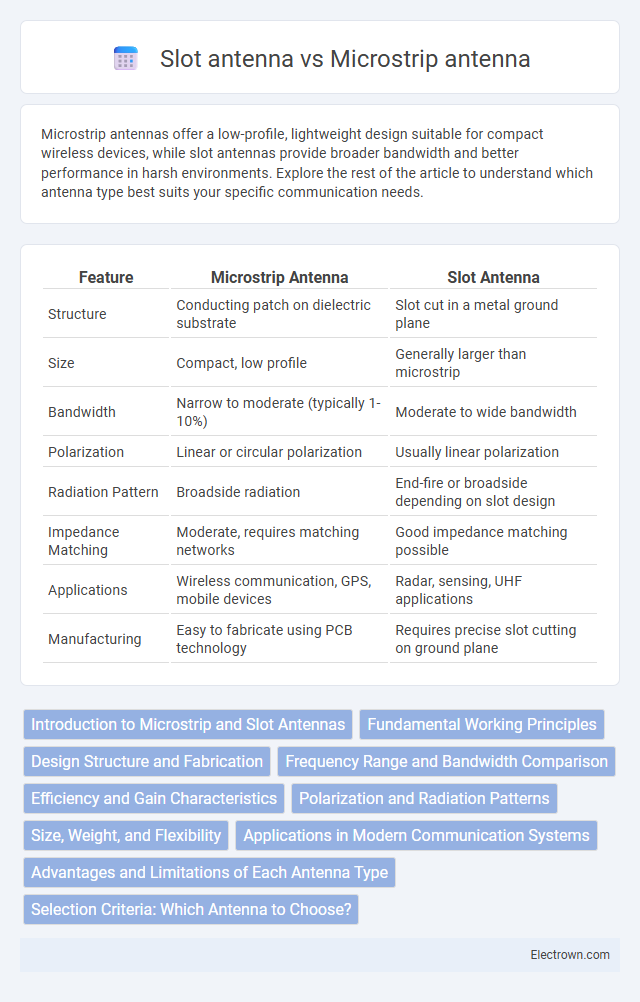Microstrip antennas offer a low-profile, lightweight design suitable for compact wireless devices, while slot antennas provide broader bandwidth and better performance in harsh environments. Explore the rest of the article to understand which antenna type best suits your specific communication needs.
Table of Comparison
| Feature | Microstrip Antenna | Slot Antenna |
|---|---|---|
| Structure | Conducting patch on dielectric substrate | Slot cut in a metal ground plane |
| Size | Compact, low profile | Generally larger than microstrip |
| Bandwidth | Narrow to moderate (typically 1-10%) | Moderate to wide bandwidth |
| Polarization | Linear or circular polarization | Usually linear polarization |
| Radiation Pattern | Broadside radiation | End-fire or broadside depending on slot design |
| Impedance Matching | Moderate, requires matching networks | Good impedance matching possible |
| Applications | Wireless communication, GPS, mobile devices | Radar, sensing, UHF applications |
| Manufacturing | Easy to fabricate using PCB technology | Requires precise slot cutting on ground plane |
Introduction to Microstrip and Slot Antennas
Microstrip antennas consist of a metallic patch on a grounded dielectric substrate, providing low-profile, lightweight, and easily fabricated solutions for wireless communication systems. Slot antennas operate by etching a slot in a metallic plane, exciting slot modes that offer wide bandwidth and unidirectional radiation patterns. Both antenna types are widely used in applications like radar, satellite, and mobile communications due to their complementary characteristics and integration flexibility.
Fundamental Working Principles
Microstrip antennas operate by radiating electromagnetic waves through a metallic patch placed on a dielectric substrate, where the patch acts as a resonator creating surface currents that emit radio frequency signals. Slot antennas function by exciting a slot, or aperture, cut into a metal plane, with electromagnetic waves radiating from the slot edges due to the distribution of surface currents around the aperture. Understanding these fundamental working principles helps you select the appropriate antenna type for applications demanding compact size, bandwidth, and radiation pattern characteristics.
Design Structure and Fabrication
Microstrip antennas consist of a conductive patch on a dielectric substrate with a ground plane, offering a low-profile and planar design favorable for easy fabrication using printed circuit board techniques. Slot antennas feature a radiating slot cut into a metal surface, typically a ground plane, with the slot shape and size directly influencing resonance and bandwidth, making their fabrication reliant on precise etching processes. Your choice between these antennas depends on fabrication capabilities and design requirements such as profile, bandwidth, and integration with circuitry.
Frequency Range and Bandwidth Comparison
Microstrip antennas typically operate within the 1 GHz to 40 GHz frequency range, offering moderate bandwidths often limited to a few percent of the center frequency, making them suitable for narrowband applications. Slot antennas provide a broader bandwidth, frequently spanning several gigahertz, and can cover frequencies from UHF up to millimeter-wave bands, which enhances performance in wideband and multiband systems. Your choice between microstrip and slot antennas depends on the required frequency range and bandwidth, with slot antennas excelling in wideband coverage and microstrip antennas favoring compact, narrowband designs.
Efficiency and Gain Characteristics
Microstrip antennas typically offer moderate gain and efficiency due to substrate losses and surface wave excitation, making them suitable for compact, low-profile applications. Slot antennas generally provide higher efficiency and gain by radiating through apertures in a metallic surface, reducing dielectric losses and enabling broader bandwidth. Your choice depends on whether you prioritize compact size and ease of integration (microstrip) or superior radiation efficiency and gain (slot antenna).
Polarization and Radiation Patterns
Microstrip antennas typically exhibit linear polarization with stable radiation patterns characterized by a single main lobe and low back radiation, making them ideal for directional communication. Slot antennas can support various polarization types, including linear and circular, due to their versatile slot geometries, while their radiation patterns often offer broader beamwidths with higher side lobes compared to microstrip antennas. Your choice depends on the need for specific polarization stability and desired radiation coverage in your antenna application.
Size, Weight, and Flexibility
Microstrip antennas are typically smaller and lighter than slot antennas, making them ideal for compact and weight-sensitive applications such as wearable devices and UAVs. Slot antennas offer greater flexibility in frequency tuning and polarization control, benefiting multifunctional and reconfigurable communication systems. Your choice depends on prioritizing minimal size and weight versus enhanced design adaptability.
Applications in Modern Communication Systems
Microstrip antennas are widely used in modern communication systems for applications requiring compact, lightweight, and low-profile designs, such as in mobile devices, GPS, and satellite communications. Slot antennas, with their ability to operate over wide bandwidths and withstand harsh environmental conditions, are ideal for radar systems, wireless networks, and aerospace applications. Your choice between these antennas depends on specific requirements like frequency range, size constraints, and environmental robustness in your communication system design.
Advantages and Limitations of Each Antenna Type
Microstrip antennas offer compact size, low profile, and ease of fabrication, making them ideal for portable and integrated devices, but they suffer from limited bandwidth and lower power handling capabilities. Slot antennas provide wider bandwidth and higher power tolerance, with improved robustness against environmental factors, yet their larger size and complex fabrication can restrict integration into compact systems. Understanding these trade-offs helps you select the suitable antenna type for applications balancing size, efficiency, and performance requirements.
Selection Criteria: Which Antenna to Choose?
Microstrip antennas excel in applications requiring low profile, lightweight, and easy integration with printed circuit technology, making them ideal for compact and portable devices. Slot antennas offer superior bandwidth and power handling, suited for high-frequency and wideband communication systems where robustness and efficiency are critical. Selection depends on specific requirements such as the desired frequency range, size constraints, bandwidth, and environmental conditions, with microstrip favored for miniaturization and slot antennas preferred for performance in harsh environments.
Microstrip antenna vs slot antenna Infographic

 electrown.com
electrown.com